Ijraset Journal For Research in Applied Science and Engineering Technology
- Home / Ijraset
- On This Page
- Introduction
- Conclusion
- Copyright
The Study of Strength and Durability Characteristics of Coir Fibre in Footing Resting on Black Cotton Soil using Ground Improvement Techniques
Authors: Murchana Mahanta Barman , Arshad Hussain, Ahmed Hussain, Md. Kamrul Islam, Apratim Narayan Baruah, Dhritikesh Nath, Md Sadiq, Nekibuddin Ahmed
DOI Link: https://doi.org/10.22214/ijraset.2023.54556
Certificate: View Certificate
Abstract
Introduction
I. INTRODUCTION
The stability, safety and durability of any structure depend entirely on the sub structural component called „Foundation?. A good foundation is the one that distribute the load evenly on soil without subjecting to overstressing. Therefore for the safety of the construction to study the properties of the soil on which foundation is resting. Thus, Geotechnical & structural engineers must check for bearing capacity of soils during foundation design.
A. Foundation Types
Keeping depth as criteria the foundation are mainly classified as 2 types
- Shallow foundations
- Deep foundations
According to Terzaghi, The foundations whose depth of foundation Df , is less than width B of foundation are referred to as Shallow foundations, whereas the foundations whose depth of foundation Df , is greater than its width B belongs to Deep foundations.
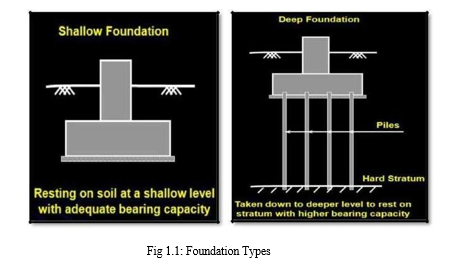
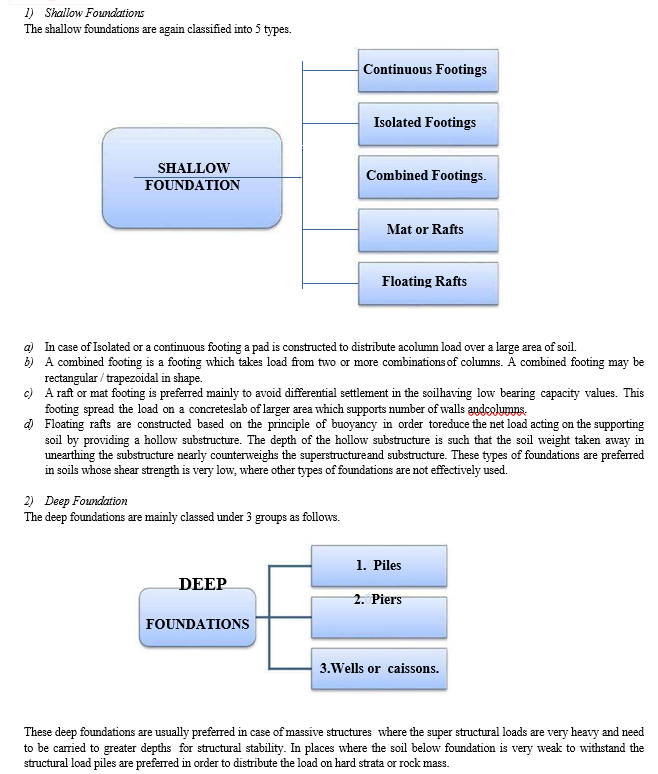
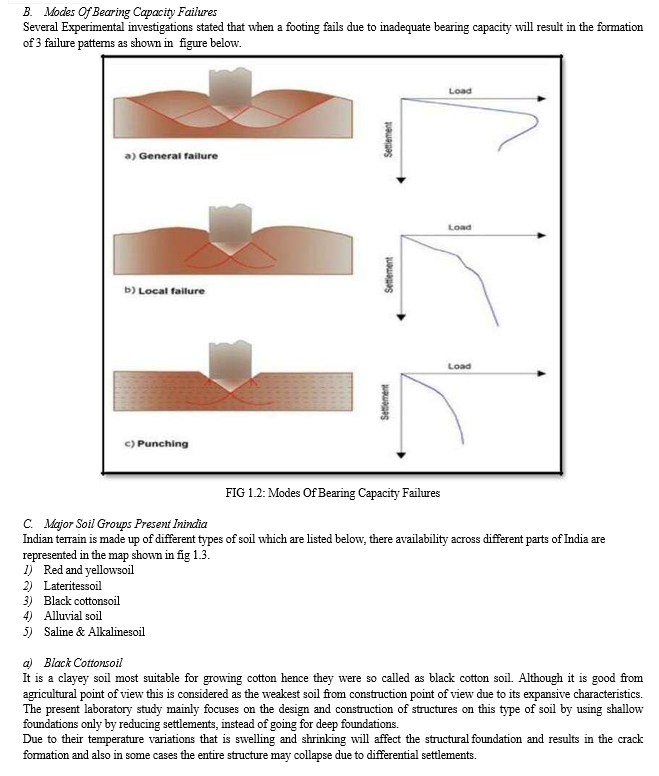
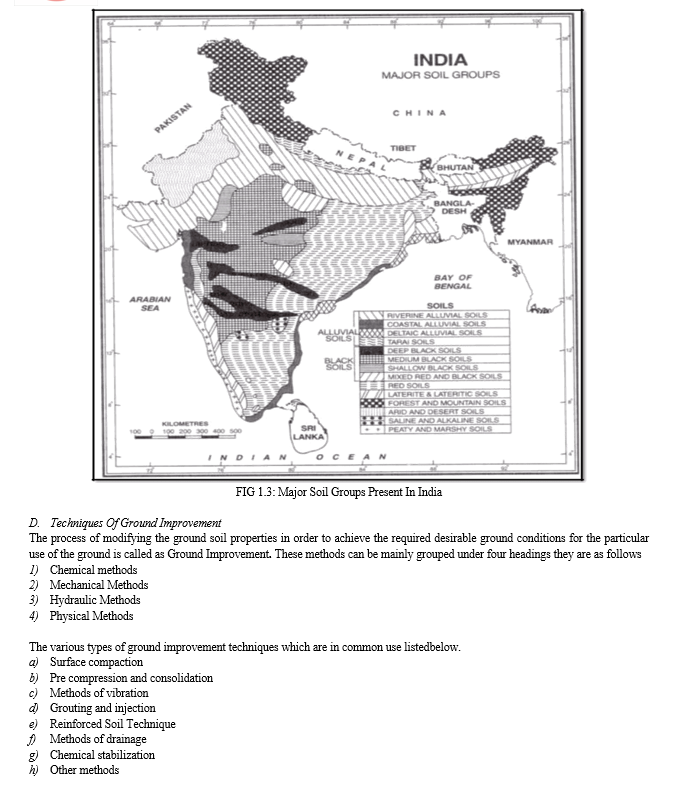
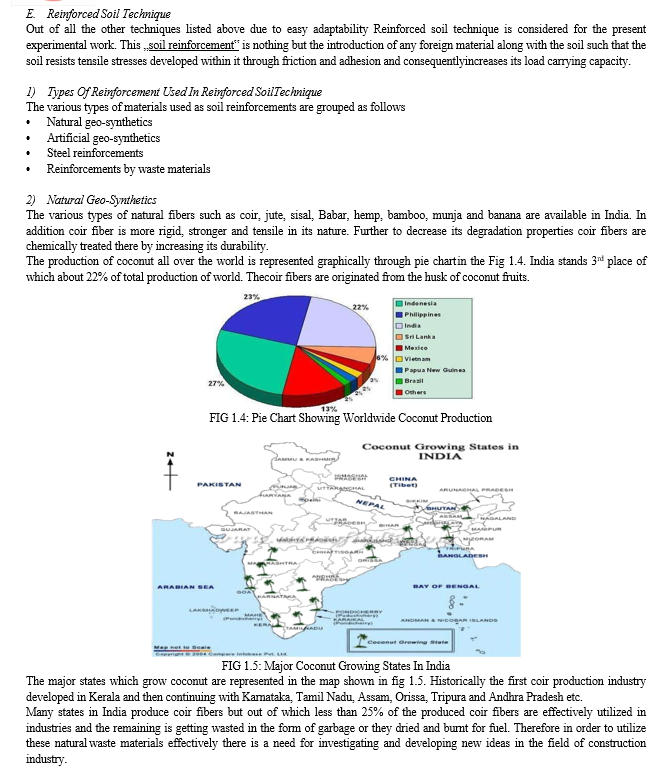
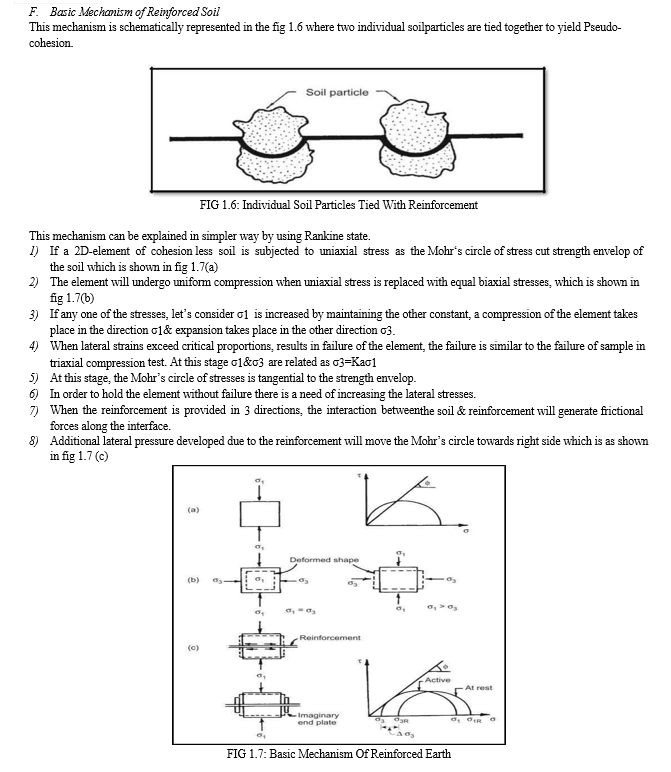
G. Methods Of Placing Soil Reinforcement
There are mainly two ways in which the reinforcement is placed along with the soil theyare
- Layer By Layer Distribution Offibers
As the name indicates in this method the reinforcement say coir fiber is arranged in layer by layer that is they are provided in horizontal layers throughout the height of soil layer. In this method the effect of reinforcement is not uniform, so chances of development of voids and gap is more hence this method has got less importance when compared to other one.
2. Randomly Distributed Fibers (RDFS)
In this method the reinforcing element say coir fibers are distributed in a random fashion. In the present work we are incorporated RDFS method for analyzing the strength behavior of BC soil for different conditions.
Comparatively this method has more advantageous when compared to layer by layer distribution. The inclusion of fibers in randomly fashion has shown considerable rise in shear strength & stiffness of BC soil as the curing period passes. The concept of RDFS is new in the geotechnical field and many researches are going on to explore the hidden aspects of RDFS. The composite material so formed due to the inclusion of fibers along with the soil is also called as Ply soil’. In case of layer method the reinforcement is provided in specific direction which will make the soil weak in the other direction whereas in case of ply soil the isotropy in strength is maintained uniform throughout. Thus preparation method is similar to the conventional stabilization technique. Generally the random reinforcement can be provided to various soil types in the form of discrete fibers, mesh elements, waste plastic strips continuous yarn or filament, metallic powes, waste tire chipsetc.
H. Advantages Of Fibre Reinforcedsoil
The main advantages of the randomly distributed fiber reinforced soil are as follows
- Increased shear strength by maintaining uniform isotropy throughout.
- Post peak strength losses are reduced.
- It provides erosion control and facilitates the vegetation growth.
- Increased ductility and seismic performance are obtained.
- In case of soils of expansive behavior the swelling and shrinkage rates are reduced.
- No appreciable changes when comes to permeability.
- This method is not much affected due to weather conditions unlike other chemical stabilization methods, cement, lime stabilization etc.
I. Practical Applications Of Reinforced soil
They can be effectively used in many engineering practical applications few of them are listed below
- In railway embankment
- In reinforced earth dams
- In construction of quay walls
- In bridge abutment
- For providing horizontal platforms in case of sloping ground
- Used as foundation slab
- For providing sharp differences of level between two horizontal platforms
- In underground mining system
- In reinforced earth arches
II. LITERATURE REVIEW
The review of various literatures referred in order to have a thorough knowledge; Implementing new ideas and point of reference with respect to present experimental investigations are as follows.
BINQUET AND LEE (1975): They have studied the strength & deformation characteristics of footings resting on reinforced sand layer. They concluded the Bearing capacity ratio (BCR), at some particular settlement, will not increase due to the increase in reinforcement proportions i.e. they are not proportional. The graphical curve of BCR & Number of layers of reinforcement almost becomes straight line after six to seven layers of reinforcement.[1]
MC GOWN et al. (1978): They outlined the differences between high & low modulus reinforcements and divided in 2 major groups as ideally inextensible& ideally extensible inclusions. The metal strips & bars will come in inextensible whereas natural fibers, synthetic fibers, polymeric fabrics & plant roots belong to extensible category. Heimdahl & Drescher in 1999 justified that the placement of reinforcement in any particular direction will leads to development of weak planes causing anisotropy which in turn results in reduction of directional strength. [2]
YETIMOGLU T SALBAS O (2003): They performed direct shear tests to analyze the strength behaviour of reinforced sand by using RDFs technique. From the test results it is found that adding fibers won?t affect peak shear strength & initial stiffness to greater extent. [3]
HUANG GU (2009): Using NaOH solution of which the concentrations varied from 2% to 10% the brown coir fibers was treated. Then the alkali-treated fibers tensile strength was measured. The fibre tensile strength is reducing and increasing in NaOH density, so severe fibre deterioration was found in 10% NaOH solution. The composite tensile strength difference among the cases of 2%, 4%, 6% & 8% of NaOH were insignificant. This confirmed the coir fibers was found due to alkali treatment for up to a max of 8% of NaOH.[4]
MAMATHA, H.V (2010): They studied the effects of randomly distributed coir fibers &lime on the strength properties of BC soil and also the effects of bitumen coated coir fibers separately. They conducted a cycle of compaction & unconfined compressive strength tests by using different proportions of coir along with optimum lime. The UCS samples are allowed for a curing period of 180 days. From graphical representation it as showing more in strength of soil up to 30 days linearly with curing period, after 30 days of curing period the improvement in strength was found to be marginal. Through test results it is found that 4% lime & 1% coir fiber of 0.5cms length were found to be optimum resulting in the improvement of soil strength and bitumen coating is not much effective in compare with the uncoated coir as for as strength is concerned. [5]
H. N.RAMESH (2011): They investigated on the water absorption and durability conditions of Coir fibers for the effective use in reinforcement. They conducted water absorption tests for both uncoated & kerosene coated coir fibers by considering 100% submerged condition. The weights of both are taken at suitable intervals of time and they are compared with unsoaked weights of uncoat or coat.[6]
SAYYED MAHDI HEJAZI ET AL. (2011): The introduction of fibers in discrete RDFs form results in the improvement of Stiffness characteristics & strength of soil. The improvement in strength due to fiber inclusions was mainly depends on properties like aspect ratio, skin friction & modulus of elasticity. [7]
AMIN CHEGENIZADEH (2011): CBR test was conducted on a geosynthetic fiber reinforced clayey soil. During pavement design the CBR results are very essential, the reinforcing of subgrade soil of pavement leads to improves the clayey soil strength. They concluded that the uses of short RDFs in clay are practicable. [8]
M.T. PRATHAP KUMAR & R.SRIDHAR (2012): Coir fibers were used to reinforce the sand, the behaviour of mat foundation resting on this reinforced sand was investigated. Load tests were carried out by considering different lengths of fiber of coir. Through load tests it is found that the inclusions of fibers considerably increase the strength in the soil. From model footing strength &settlement aspects, the optimum depth of coir fibre reinforcement zone is found to be 0.8b below the base of the footing, where b is width of the footing. [9]
PREETI VERMA (2012): They concentrated on the durability and degradability of the natural coir fibers for the effective use in geotechnical applications. They treated the coir fibers by using different treatment methods like alkali treatment, acetylation, permanganate treatment & heat treatment to investigate the moisture absorption capacity of particular treated coir fibers and there moisture absorption characteristics were studied. Through test results it is found that chemically treated coir have successfully modified its structure & also minimized moisture absorption tendency.[10]
PARAG M. CHAPLE & A.I. DHATRAK (2012): They conducted model footing tests by considering square footing resting on highly compressible clayey soil reinforced using RDCFs to study the bearing capacity & settlement characteristics. They have considered reinforced soil layer thickness of B, 0.25B & 0.5B along with varying percentage of coir fibers such as 0.25%, 0.5%, 0.75% & 1.0%. It is observed that the BCR increases up to 1.5to 2.66 due to reinforcement. The maximum SBC is found for 0.5% fiber proportion at 25 mm depth of reinforced soil (B/4).
They suggested that the soil is affected to a significant depth of 2 to 2.5 times the width of the footing, so it is not necessary to put reinforcement for the entire depth of the soil. The provision of coir reinforcement minimizes the settlement there by improving the bearing capacity.[11]
H.P. SINGH (2013): In this study, number of tests is conducted on RDCF reinforced soil. The soil samples were prepared at its MDD & OMC for both conditions that is with and without RDCF. The coir fibers proportions 0.25%, 0.5%, 0.75%, 1% by dry weight of the soil were used and for each fiber content separate CBR tests were conducted for both soaked & unsoaked condition. Due to the inclusion of coir fibers the CBR value of soil increases significantly which reduces the pavement subgrade thickness substantially.[12]
Dr. M.T PRATHAP KUMAR AND JAIRAJ .C (2014): They studied the effect of lime treatment & length of coir fiber on peak deviator stress & shear parameters by conducting undrained triaxial tests on reinforced BC soil. From the test results they observed that addition of lime to BC soil results in increase in peak deviator stress. The shear parameters angle of internal friction & cohesion increases with increase in coir fiber lengths up to 20mm above which causes marginal reduction in shear parameters causing mixing difficulty.[13]
GODAVARTHI VENKATA RAMASUBBARAO (2014): Kerosene coated Coir fibers are used as reinforcement along with the expansive soil in the present case. 5mm long kerosene coated coir fibers in various proportions of 0%, 0.5%, 1%, and 1.5% are distributed randomly along with the soil. Water absorption tests, and Standard Proctor tests study the strength behaviour of coir fibers and soil. Both uncoated& kerosene coated fibers are tested to check water absorption capacity. The result shows that there is a considerable reducing the water absorption of kerosene coated coir fiber with that of uncoated coir. Out of all proportions 1% of coated coir fiber is found to be the optimum coir content from UCC strength point of view. The Split tensile strength of reinforced soil using 1% coated fiber was found to be increased by 50% that of the unreinforced soil. [14]
PRIYANKA GOYAL et al. (2015): Coconut coir fibers were used to minimize the swelling behaviour of black cotton soil. They conducted the unconfined compressive strength and swelling tests on BC soil with inclusion of 2% fiber content. The results shows that there is a significant increase in shrinkage limit, compressive strength & optimum moisture content due to blending of 2% coir fibers along with the BC soil. [15]
STUTI MAURYA, Dr. A.K.SHARMA et al. (2015): They concluded that the coir fiber can used as effective reinforcing material which improves strength & stiffness of soil. The coir fibers with different length & proportions affect the soil properties; there is a need of further research on degradation of coir fibers.[16]
III. MAIN OBJECTIVES AND SCOPE
A. Main Objectives of Present Investigation
The prime objectives of the current experimental work are as follows
- To study the basic properties of the BC soil and basic properties of coir fiber.
- To reducing construction cost by using naturally available coir fibers and industrial waste products.
- For to find the strength of BCS is reinforcing to TCF resting on loose stratum through different size of model footings i.e. 0.05 m& 0.025 m.
- A comparative study on BC soil reinforced with TCF& unreinforced BC soil by considering static load conditions.
- Influence of various criteria like width of model footings, depth of fiber reinforced BC soil layers and settlement characteristics.
B. Scope Ofwork
- A standard chemical treatment procedure to make coir fiber water repellent to decrease its biodegradability.
- Effective usage of many industrial wastes as fiber reinforcement along with soil.
- Behavior of compaction characteristics of BC soil along with TCF reinforcement
- The work can also be further experimented by blending with TCF for different proportions for different densities and trying with new chemicals or materials which makes coir fiber more water repellent.
IV. TREATMENT OF COIR FIBRE
The primary purpose of this modification of coir fibers by the treatment is to minimize its water absorption properties & to make it as a water proof material. Many researchers have been attempted and developed various methods for the treatment of fiber of coir & the yare
- Chemical treatment
- Graftco-polymerization
- Coating polymeric solutions
Out of above the chemical treatment was performed in the current study. The most commonly used methods for treating natural fibers by chemical means are as follows.
- Alkali treatment
- Acetylated treatment
- Heat treatment
- Permanganate treatment
A. Alkali Treatment
The Alkali treatment also called as mercerization is one of the best suited chemical treatment method for treating natural fibers. In this process partially amorphous constituents such as lignin, hemicellulose, waxes, & oils soluble in alkaline solution are eliminated & therefore it reduces the level of fiber aggregation, making the surface materialrougher.
Many investigators are experimented and studied the moisture absorption of surface TCF& they were found that there is a reduction of about 30% of water absorption by TCF. Hence in the present work alkali treatment was used.
The step by step procedure used in the present chemical treatment of Coir Fiber is represented in the form of flow chart as below.
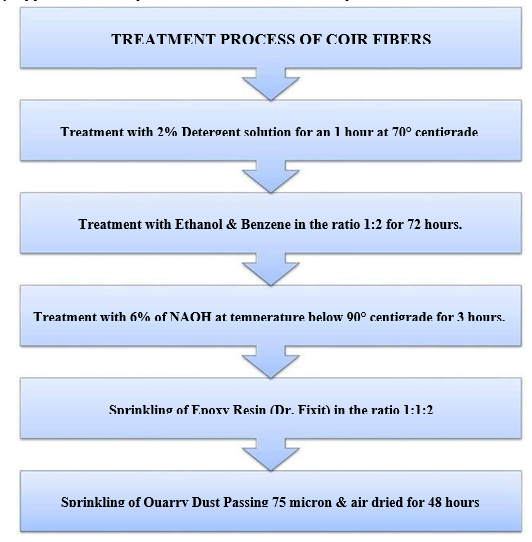
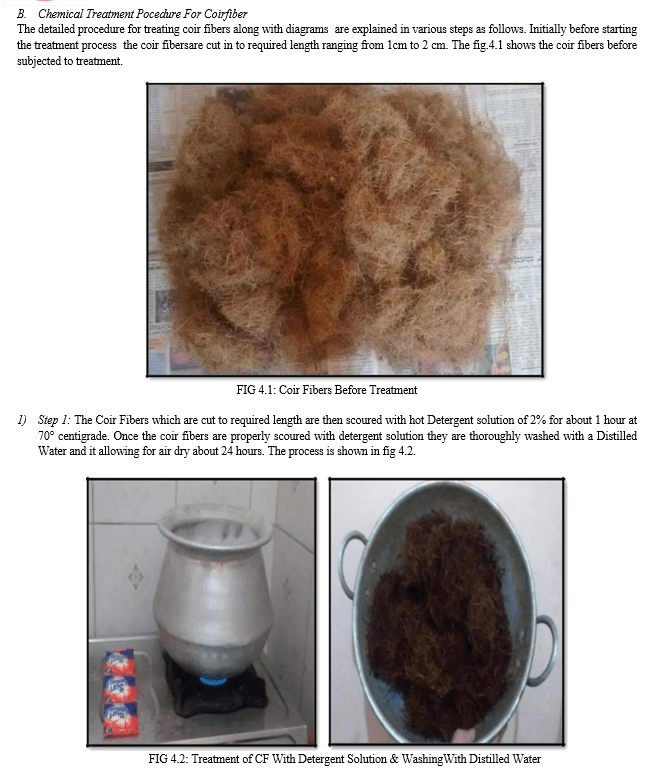
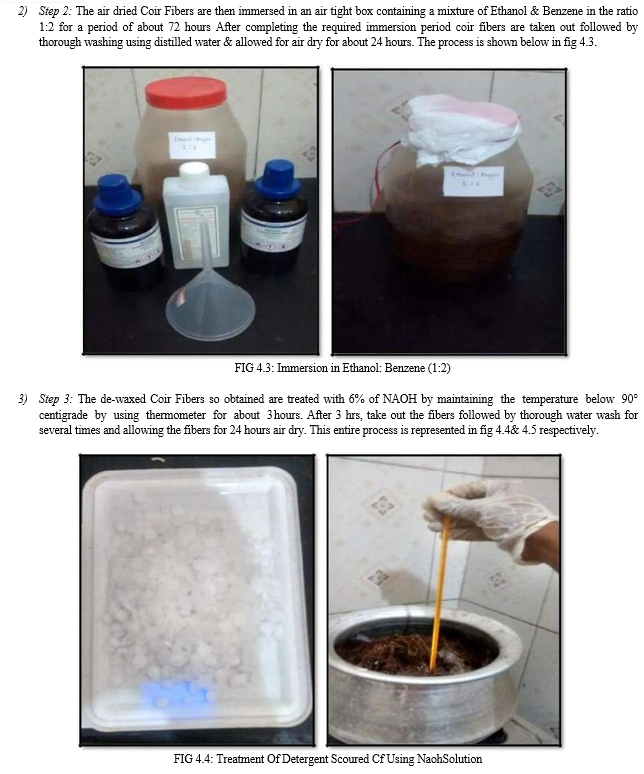
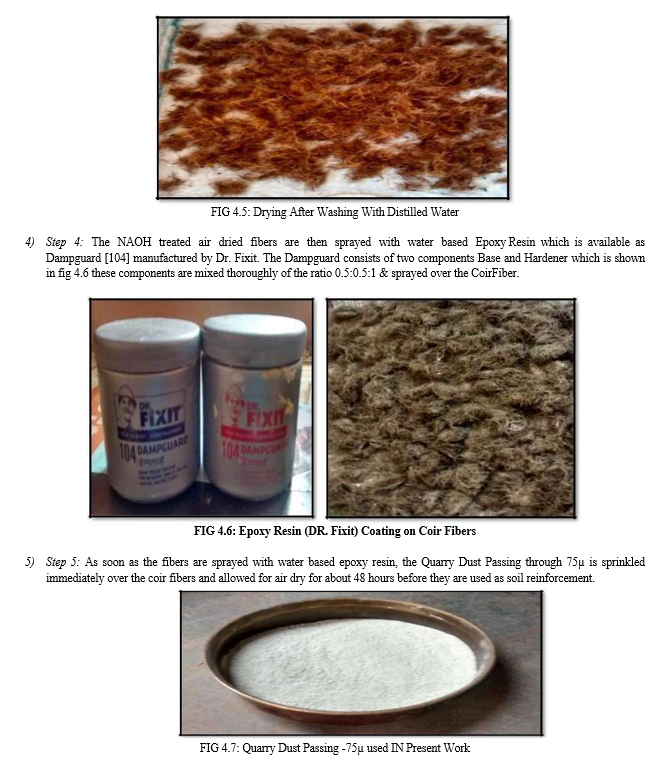
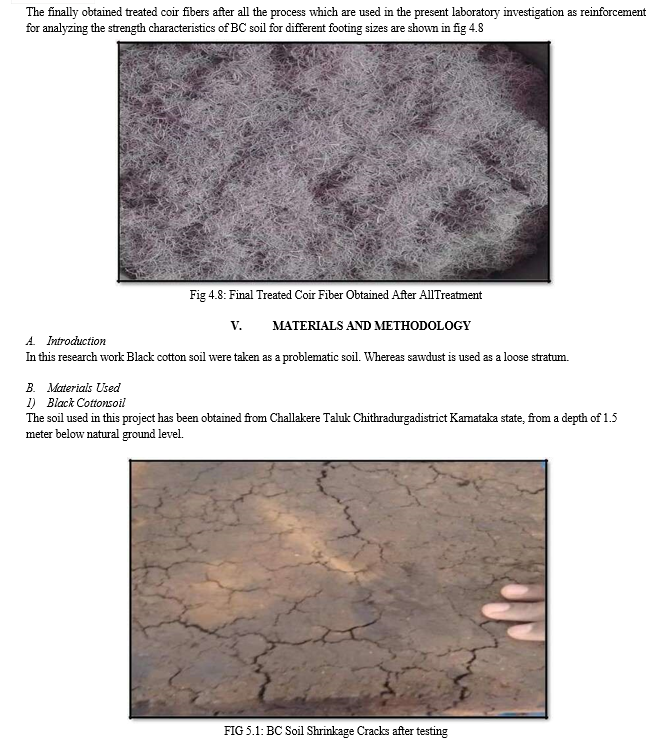
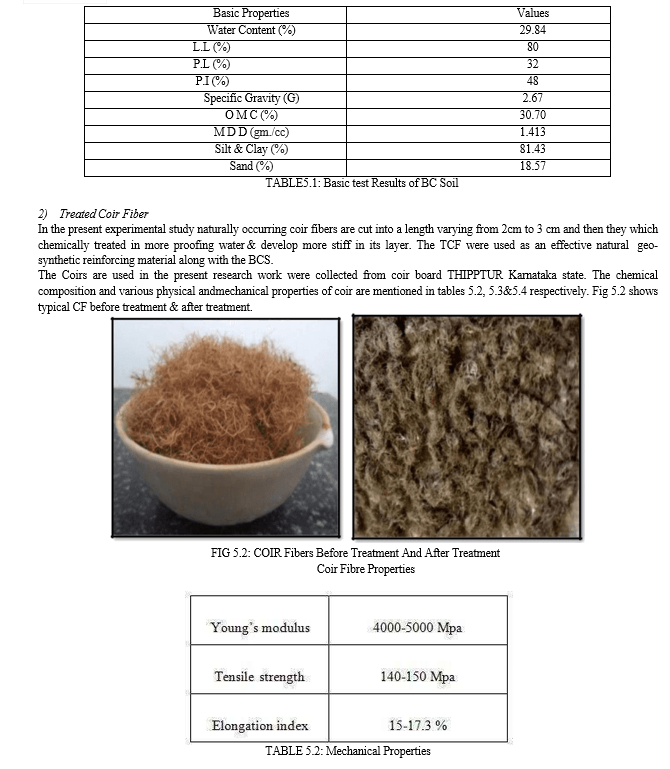
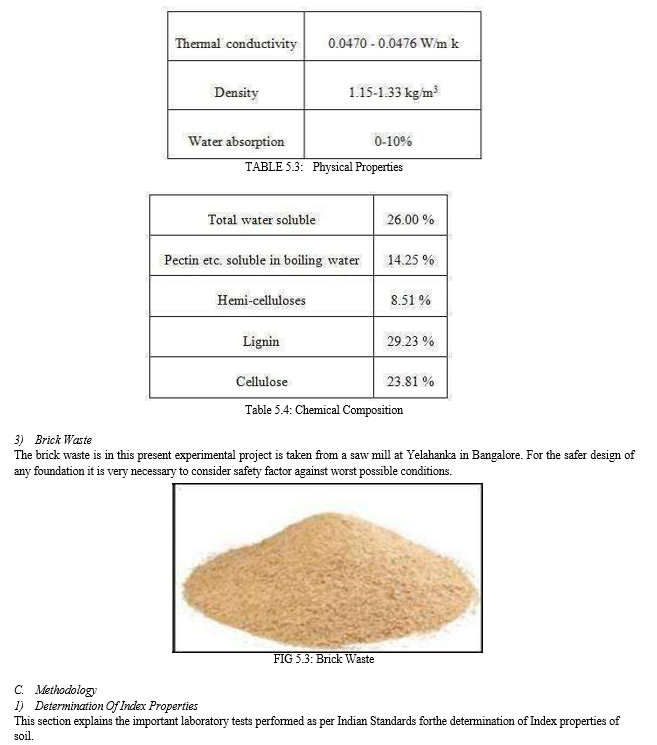 \
\
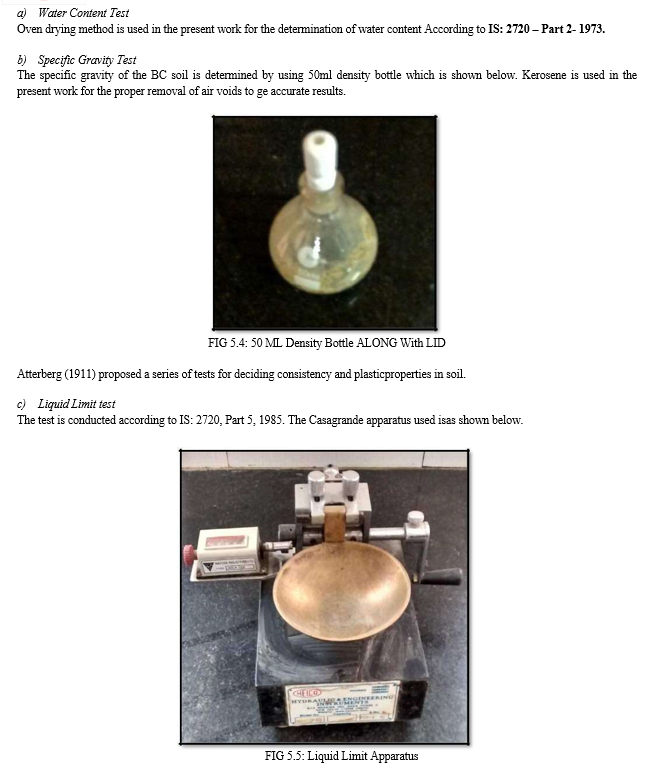
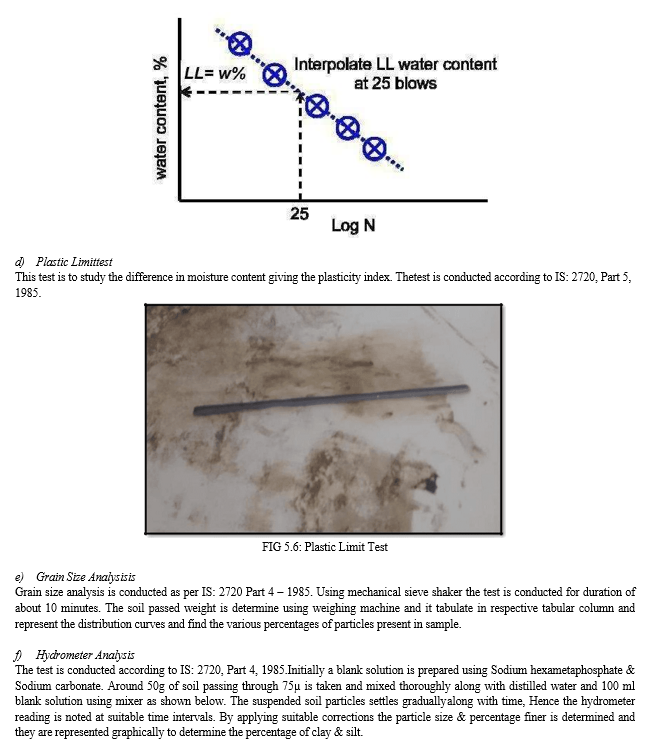
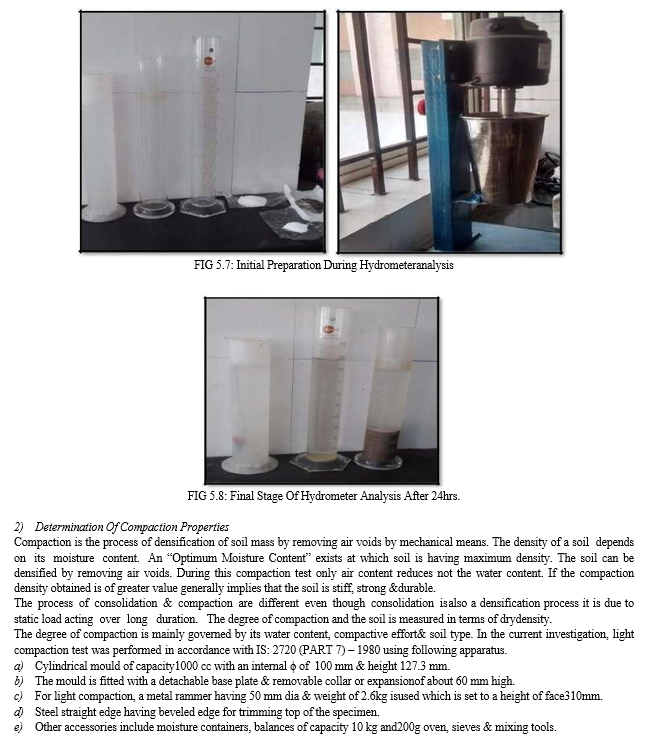
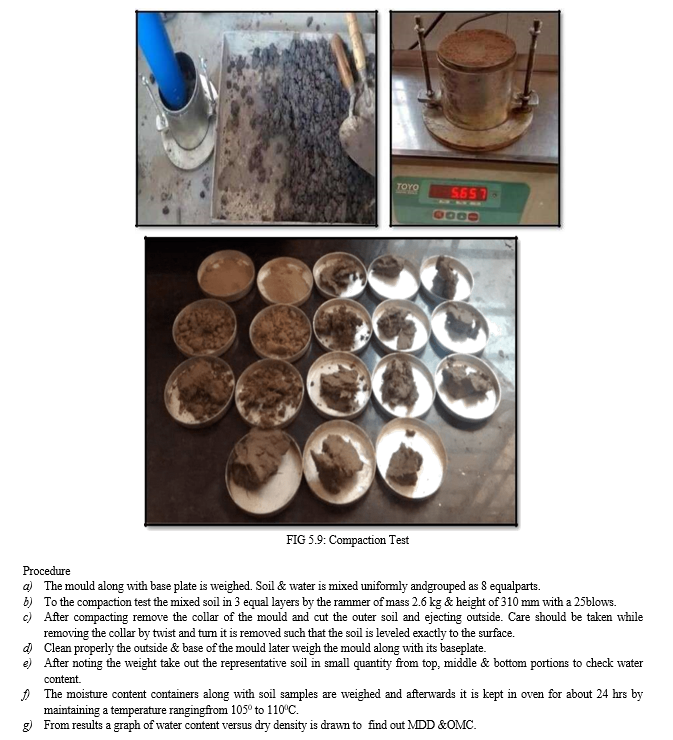
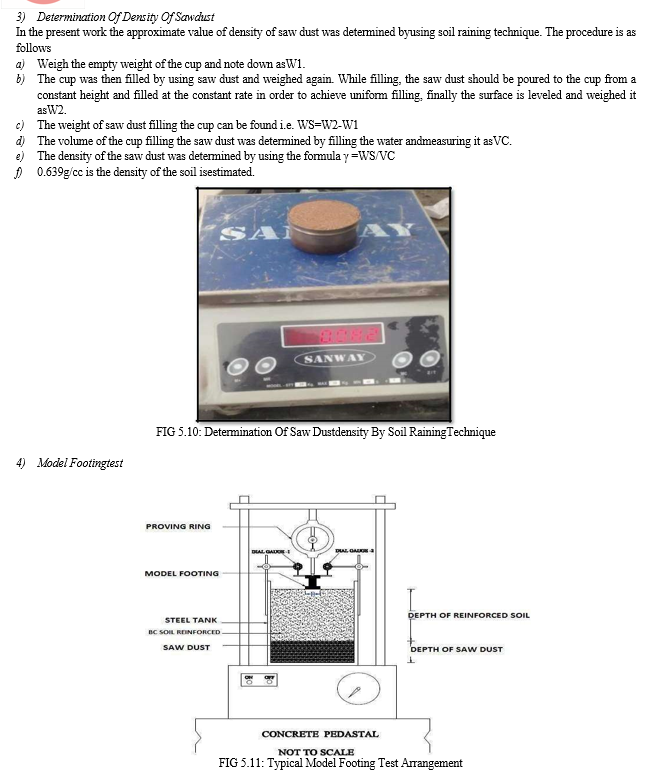
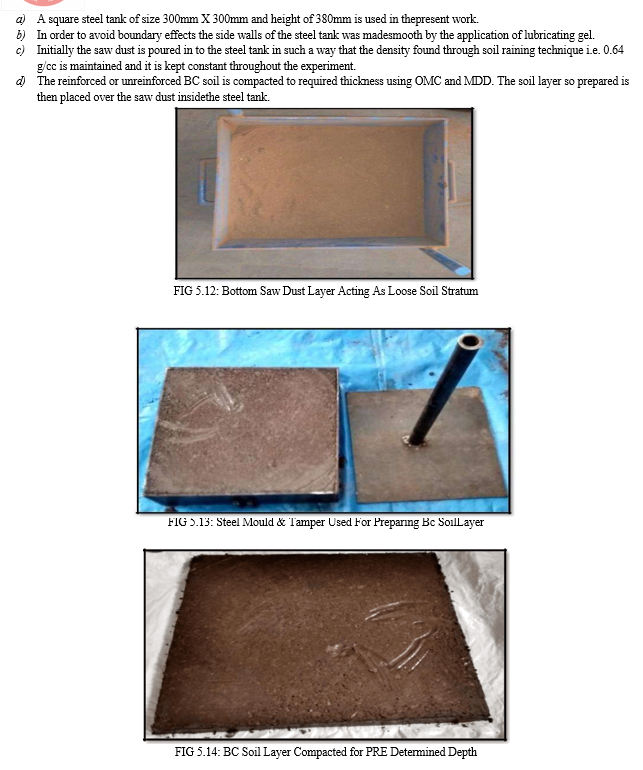
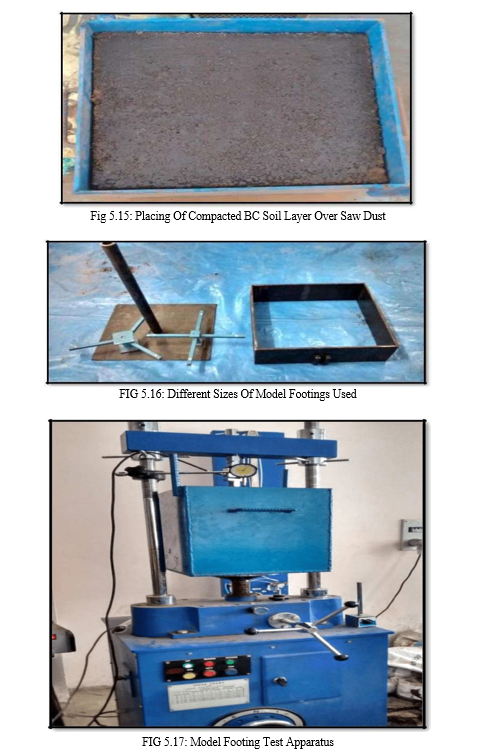
VI. RESULTS AND DISCUSSIONS
A. Introduction
One of the real difficulties for Geotechnical Engineers is in the construction of any structures on exceptionally risky soils, for example, BC soil and in the soil having loose stratum. Because of excessive settlement or compression of such soils will result in the failure of the structure as a whole. Therefore it is very essential to take precautions during the design and construction stage itself in order to avoid any future damage to the building foundation. The following precautions or alternatives are recommended for the construction on black cotton soil.
- For distributing load over large area & to avoid differential settlements in case of relatively important structures mat or raft foundation is provided.
- For heavy structural loads pile foundation is preferred to transfer loads to the greater depth until the hard soil or rock bed is available to take loads safely.
- If the depth of loose soil stratum present is less, it is removed totally and supplanting the hard soil.
At the point when the structure covers a littler zone, the last alternative may turn out to be efficient and practicable when contrasted with other three.
a. Surface treating coir fibers are using to reinforcement in BC soil layer, to investigate the beneficial effects and practical feasibility.
b. The OMC & MDD was determined separately for both BCS only and BCS along 0.5% TCF by conducting light compaction test.
c. The experiments were carried out on model footings resting upon compacted BC soil beds under laid by loose stratum and they are subjected to static loading.
d. Two different widths of model footings (0.05m, 0.025m), is used for different depths of reinforcing layers ranging from 0.2B to 2B and the readings are tabulated separately
e. With respect to literature studies, the optimum percentage of coir fiber to be used as reinforcements was found to be 0.5% and optimum length of fibers was 10 to 20mm same standards are implemented in the current study.
f. The saw dust is compacted to the predetermined density also the BC soil layer is compacted to the predetermined depths ranging from 0.2B to 2B using OMC and MDD which was found before.
g. The Load vs. Settlement curves was plotted and the BCR is determined. The graphical results are represented and discussed in this section.
B. Results Of Compaction Test
The test of compaction is carried by separately for BCS only and BCS along 0.5% TCF. The moisture content and density determined for each trial. Graphical representation was corresponding to dry density v/s water content in order to determine the maximum dry density in g/cc & optimum moisture content in percentage. Figure 6.1 shows typical compaction curves found for BCS along 0.5 % TCF and BC soil alone. From this test gives maximum dry density & optimum moisture content were plotted. The Maximum MDD & minimum OMC have been obtained for the BC soil along with 0.5% randomly distributed treated coir fibers. As shown in table6.1
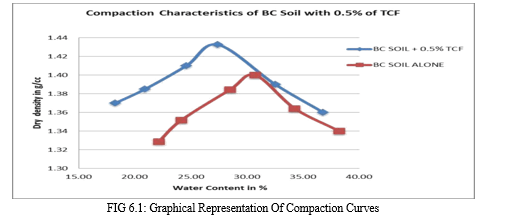
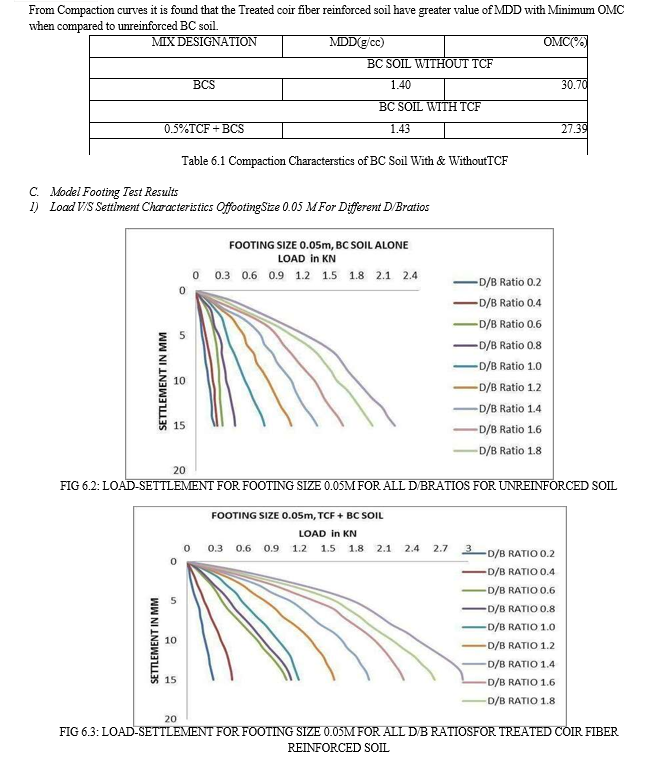
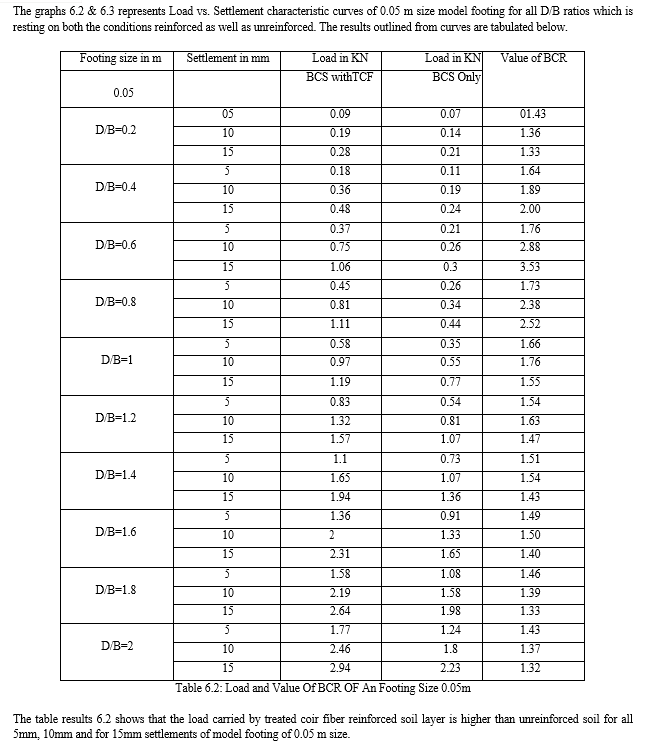
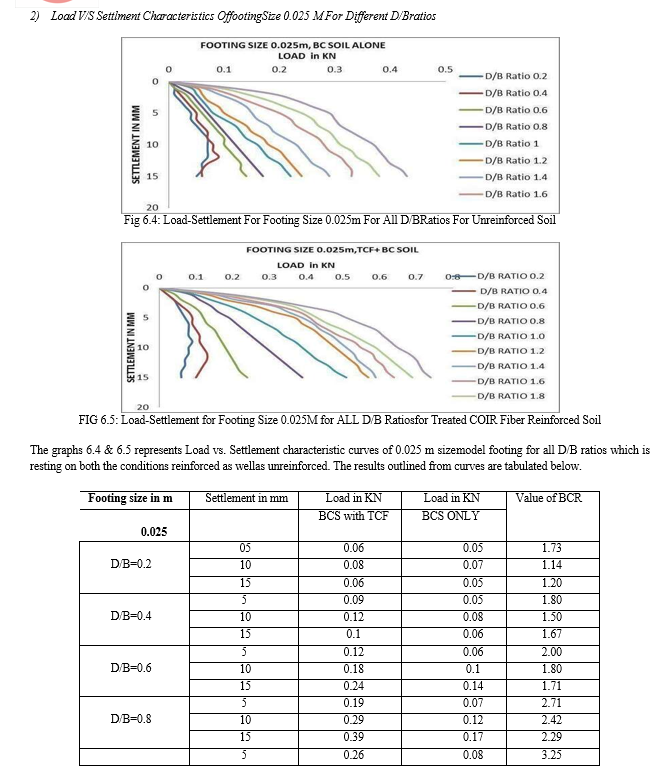
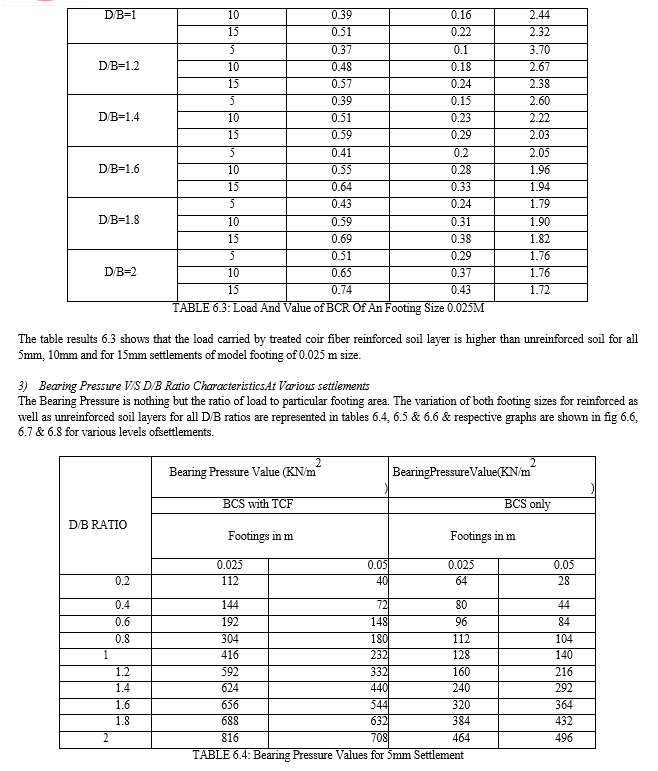
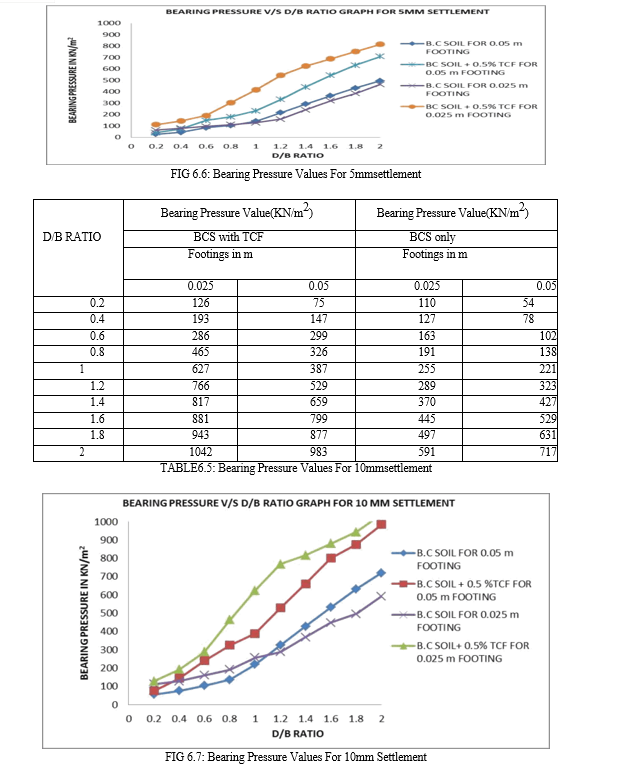
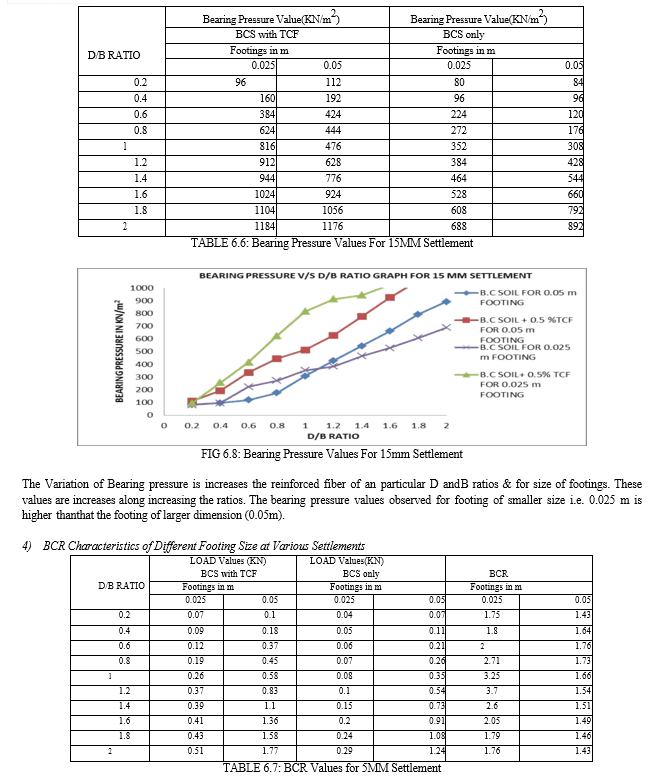
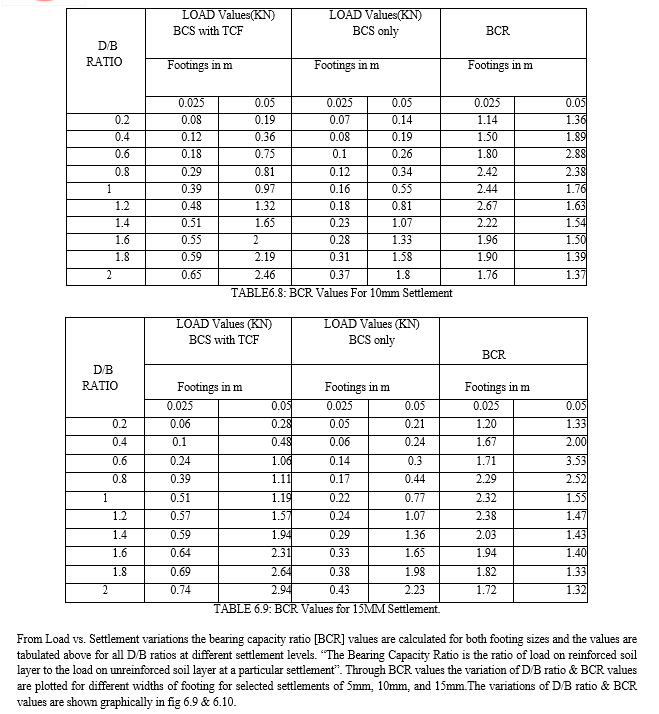
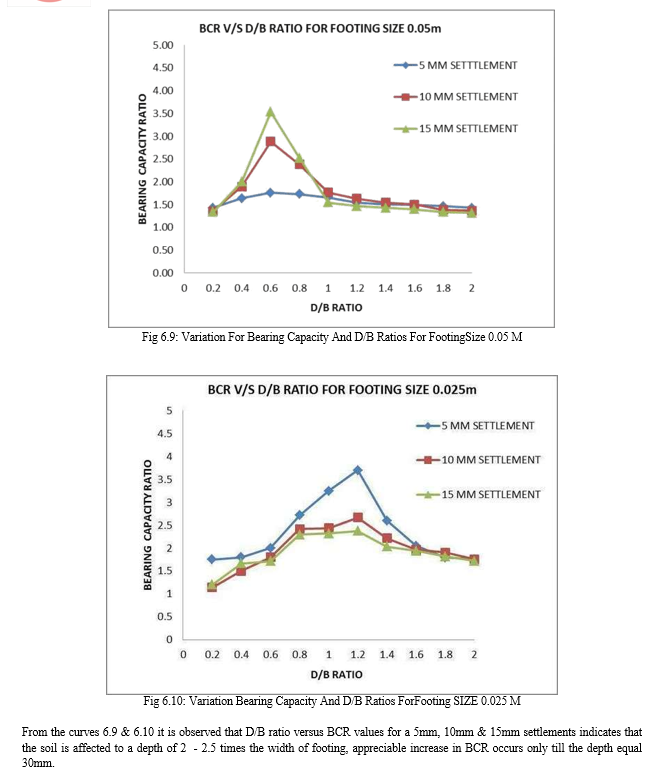
At a particular settlement the load carried by reinforced soil is considerably greater than unreinforced soil. The BCR value greater than 1 implies that there is an improvement in strength of BC soil due to treated coir fiber reinforcement
The experiment results indicate that the BCR values gradually decreases as the thickness of soil layers increases.
Conclusion
Depending on the laboratory experiment results & observations obtained due to the addition of TCF to BC soil, the entire results are concluded as below. 1) For different settlements of footings load carried by RDCFsre in forced soil was relatively more for reinforcing depths of 0.2B, 0.4B, 0.6B, 0.8B, 1B, 1.2B, 1.4B, 1.6B, 1.8B and 2B. WhereB-footing width. 2) The load bearing capacity increasing along increasing the footing width for the equal settlement. But higher BCR values are observed for the smaller footing. 3) The differences in the specified settlements for a graph of BCR ratios and D/B ratios was showed that the values of BCR is more for 0.025m footing of 1.2 D/B and 0.05m footing of 0.6 4) The soil is affected to a depth of 2 to 2.5 times the width of footing. 5) As the size of footing is increasing, The reinforced and unreinforced soil of an loose stratum overlied is increasing considerably.
Copyright
Copyright © 2023 Murchana Mahanta Barman , Arshad Hussain, Ahmed Hussain, Md. Kamrul Islam, Apratim Narayan Baruah, Dhritikesh Nath, Md Sadiq, Nekibuddin Ahmed. This is an open access article distributed under the Creative Commons Attribution License, which permits unrestricted use, distribution, and reproduction in any medium, provided the original work is properly cited.

Download Paper
Paper Id : IJRASET54556
Publish Date : 2023-06-30
ISSN : 2321-9653
Publisher Name : IJRASET
DOI Link : Click Here
 Submit Paper Online
Submit Paper Online

